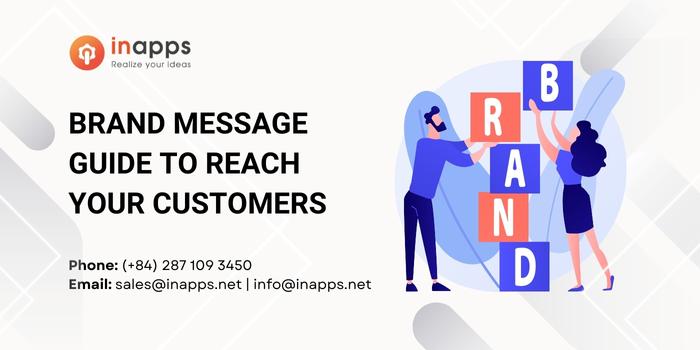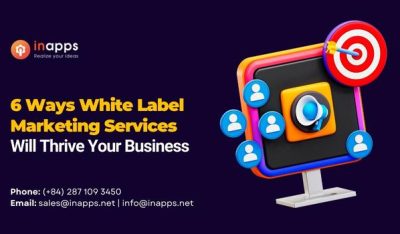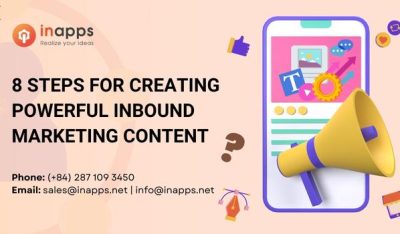- Home
- >
- Inbound Marketing
- >
- StoryBrand and 7 Steps to reach your customers
Storybrand and 7 Steps To Reach Your Customers is an article by the InApps editorial team. Hope readers will have more helpful knowledge at www.inapps.net
Messaging is a potent tool for your business. When done correctly, you can create an inseparable bond between you and your customers.
Just look at some of the biggest brands today. Through messaging, they invite the customer into a story – a personal journey – that encourages them to listen and inspires them to stay loyal to their mission.
So, how is it done? Is it luck? Pure magic? Or is there a fool-proof way to reach your customers through messaging too?
Keep reading our StoryBrand brand message guide to finding out!

via GIPHY
To answer this question, look no further than Donald Miller’s award-winning book, Building a StoryBrand. Through the art of storytelling, Miller gives a sure-fire way to win over the customer and improve conversion rates.
But don’t take our word for it. This StoryBrand brand message guide will teach you the 7 steps to developing your own StoryBrand messaging. Ready to boost your storytelling game? Let’s get started.
Key Summary
This article from InApps Technology, authored by Phu Nguyen, outlines the StoryBrand Framework, a 7-step storytelling approach based on Donald Miller’s book Building a StoryBrand. It positions the customer as the hero of a narrative, with the brand as a guide, to create compelling messaging that boosts engagement and conversions. The article explains how storytelling builds emotional connections, clarifies communication, and drives customer loyalty.
- Context:
- Power of Storytelling: Effective messaging creates strong customer bonds, as seen in major brands, by inviting customers into a personal journey.
- StoryBrand Framework: A structured 7-step process to craft clear, empathetic, and engaging brand messages, making the customer the hero and the brand the guide.
- Why Stories Work: Per Pamela Rutledge (Media Psychology Research Center), stories provide predictable, comforting narratives that help audiences process intense emotions and seek resolution.
- StoryBrand Framework (7 Steps):
- Enter the Main Character:
- The customer is the hero, not the brand.
- Define their aspirational identity (e.g., smarter, wealthier, fitter) and how the product/service facilitates transformation.
- Use clear, precise language to ensure customers see themselves in the story.
- Who is Faced with a Problem:
- Identify the customer’s problem as the story’s hook, encompassing:
- Physical: Tangible challenges (e.g., a technical issue).
- Internal: Emotional struggles (e.g., frustration, doubt).
- Philosophical: Moral conflicts (e.g., good vs. evil).
- Focus on internal conflicts to empathize and drive action.
- Identify the customer’s problem as the story’s hook, encompassing:
- But Luckily Meets a Guide:
- The brand is the guide (e.g., Cinderella’s fairy godmother), not the hero.
- Show empathy (understand customer pain) and authority (demonstrate competence via stats, awards, or testimonials) without self-focus.
- With a Fool-Proof Plan:
- Provide a simple 3-step plan to overcome “customer fog” (e.g., fears of complexity, cost, or timing).
- Example: Medical facility plan—Schedule consultation, get treatment plan, feel better.
- That Calls Them to Action:
- Use direct, confident calls to action (CTAs) (e.g., “Buy Now,” “Register Today”).
- Include transitional CTAs (e.g., email campaigns) to build relationships gradually.
- And Helps Them Avoid Failure:
- Highlight stakes using loss aversion—what customers lose without the product (e.g., time, money, peace).
- Frame pain points to keep the story relevant and urgent.
- Which Concludes with a Happy Ending:
- Emphasize the positive transformation (e.g., success, happiness) customers gain by using the product.
- Reinforce the happy ending across all messaging to inspire action.
- Enter the Main Character:
- Why Storytelling Matters:
- Clarity Drives Purchases: Customers buy products communicated clearly, not necessarily the best ones.
- Emotional Connection: Stories engage audiences by addressing pain points and offering resolutions, fostering loyalty.
- Applications: Use the framework for websites, landing pages, social media, and email campaigns to maintain a consistent narrative.
- Execution Tips:
- Align internal teams with the BrandScript for consistent messaging.
- Keep communication simple, repetitive, and customer-focused.
- Avoid vague or self-centered language to ensure clarity.
- Example: Cinderella as a StoryBrand:
- Hero: Cinderella (customer).
- Problem: Evil stepmother/stepsisters (pain points).
- Guide: Fairy godmother (brand).
- Plan: Attend the ball with magical help (solution path).
- CTA: Follow the fairy godmother’s instructions (buy the product).
- Stakes: Risk of eternal misery (failure without action).
- Happy Ending: Marriage to the prince (customer success).
- InApps Insight:
- InApps Technology, ranked 1st in Vietnam and 5th in Southeast Asia for app and software development, leverages storytelling to enhance client engagement.
- Uses technologies like React Native, ReactJS, Node.js, Vue.js, Microsoft’s Power Platform, Azure, Power Fx (low-code), Azure Durable Functions, and GraphQL APIs (e.g., Apollo) to create customer-centric solutions.
- Offers outsourcing services for startups and enterprises, delivering marketing strategies and digital transformation at 30% of local vendor costs.
- Supported by Vietnam’s 430,000 software developers and 1.03 million ICT professionals.
- Call to Action:
- Contact InApps Technology at www.inapps.net or sales@inapps.net to craft a compelling StoryBrand strategy or develop customer-focused mobile and web solutions.
What is the StoryBrand Framework?
Miller gives brands a clear-cut path to masterful messaging in his book and through his Business Made Simple online courses. He calls his precise formula the StoryBrand Framework.
In simple terms, StoryBrand Framework is a 7-step process that positions the lead as the center of the story.
StoryBrand Basics: What’s the secret?
As the hero, the lead faces a menacing problem they must conquer to live a better life. Luckily, the brand (i.e. your business) is here to save the day!
Through clarity, empathy, and authority, the business becomes the guide in the story and gives the lead the tools they need to easily navigate to the right solution: their product or service.
At the end of the day, the lead overcomes their problem and becomes a paying customer, making it a true success story for both client and company. All of this is accomplished through storytelling!
Why a Clear Story is the Key to Success
You might be wondering, “Why storytelling? Can stories really be that impactful?”
Yes, they are extremely impactful! Never underestimate the power of a good story.
According to research presented by Pamela Rutledge, the Director of the Media Psychology Research Center, “Stories provide order. Humans seek certainty and narrative structure is familiar, predictable, and comforting. Within the context of the story arc, we can withstand intense emotions because we know that resolution follows the conflict.”
So, when a business can adopt GOOD storytelling into their marketing campaigns, they can instantly increase their position in their clients’ minds. Here’s how.
How Story Works: An Example
If you clarify your message, customers will listen. Story does an extremely great job of capturing the audience’s attention and forming a clear message.
Let’s take a look at a story everybody knows: Cinderella.
Cinderella: A Story as Clear as a Glass Slipper
In the story, Cinderella is positioned as the lead – the hero. However, she faces a big problem: Her evil stepmother and stepsisters are ruining her life and keeping her from the prince! They are the villains of the story.
Luckily, her fairy godmother steps in to rescue her. As her guide, the fairy godmother magically grants her access to the royal ball and gives her instructions on how the magic works. Bippity, boppity, boo!

via GIPHY
However, the magic wears off when the clock strikes midnight and Cinderella races home. As you know, this is the part of the story where the prince finds her glass slipper and pursues Cinderella. The stakes are high. Cinderella might be locked in the attic forever! But, the prince has a plan to save her, and he effortlessly executed it to win the day.
The story concludes with a romantic marriage. Aww, we all love a happy ending.
What Can Your Business Learn From Cinderella?
It’s time to break it down for you. Cinderella is a representation of your potential customers. They are the heroes of the story. But, they are currently facing a big problem that is messing up their lives (aka- the villain)!
This is where YOU come in as the guide. You are the fairy godmother! You empathize with their pain point and give them a solution to their problem.
Next, the solution is like the prince character. It is there to step in and save the day. And yes, the mighty prince is your product or service.
However, in order to end the story in success, you need to lead the customer to the right solution with an easy-to-execute plan. When they follow this plan, they win and get to experience a happy ending.

via GIPHY
The Value of Storytelling
People buy products only after they read the words that make them want to buy it. In other words, people do not buy the best products. They buy the ones that are communicated the clearest.
What’s the best way to do this? Our StoryBrand brand message guide will help you.
The best way to do this is through direct, easy-to-follow storytelling!
You can use the StoryBrand Framework to create compelling copy on your website, landing pages, social media posts, email campaigns – you name it – that puts your customers at the center of the story.
This provides immense value to your company because it develops a continuous storyline for your leads to follow. It’s easy to understand, empathizes with their pain points, and builds a stronger relationship between you and your clients.
How To Use StoryBrand Framework in 7 Steps
Like Cinderella’s glass slipper, the story you invite your customers to participate in should be a perfect fit.
In this next section, we’ll dig deeper into the StoryBrand brand message guide and show you the exact steps you need to take to build a clear, concise, and engaging story.

via GIPHY
1. Enter the Main Character
First and foremost, every story needs a main character. This person is the hero of the story.
From start to finish, the entire story revolves around their dilemma, trials and tribulations, and big final victory.
When you create a StoryBrand BrandScript for your business, your customer should ALWAYS be the hero of the story. They are the main character, after all!
Now that we have made ourselves clear let’s talk about how hlet’su, as a brand, will help your main character transform into the hero they always wanted to be.
Define Your Customer’s need
All stories are about transformation. Not all heroes start out as powerful as Superman. As a matter of fact, the hero is often a very weak character who needs to overcome a problem to become strong.
Therefore, when brands help customers become better versions of themselves, they win!
It’s Time for Transformation
So, the first thing you need to do as a brand is to figure out your customer’s aspiratcustomer’stity. This is done through the story a brand tells about its product and how a customer can win.
To do this, answer these questions:
- Who does my customer want to become?
- What kind of transformational value will my product or service provide my customer?
- Will my product or service make them feel smarter, sexier, wealthier, fitter, well-adjusted, etc.?
- What do they desire and how will they get it?
Once you have defined your customer’s aspiration, it’s time to paint the story’s main character’s
Pro-Tip: Remember to use precise language when writing your story brand, and never use vague or inside language. Can your customers picture themselves as the main character of the story? If not, clear up the language.
2. Who is faced with a Problem
People are problem-solvers. When faced with an uncomfortable, painful, or stressful challenge, we want nothing more than to find a solution!
Within stories, the problem is often the hook. It grasps the attention of the audience and keeps them invested in the story. Is the hero going to overcome the problem? If you don’t tell them what type of problem you solve and how you will do it, they will not stay engaged in your story.
3 Types of Problems in Storytelling
In the world of storytelling, there are 3 main types of problems that must be solved in order to receive a standing ovation from the audience. These include:
- Physical problem: The actual physical challenge (such as defusing a bomb)
- Internal problem: How the hero feels about defusing a bomb. They might ask themselves, “Do I have what it”takes to get this done?”
- Philosophical problem: The hero vs. the villain archetype (good vs. evil)
If you can frame your customer’s narraticustomer’se all 3 of these problems when they click “Buy Now,” you will” accomplish remarkable feats.
People Buy Solutions to Internal Problems
Of the 3 problems, the main obstacle you should always tackle as a brand is an internal conflict your customer feels. How they FEEL about the problem is extremely important because it is your job to help your hero feel better.
Now, answer these questions to create the framework for your customer’s problem.
- What is my customer’s problem making them feel?
- Why is this just plain wrong?
After all, it’s WRONG for them to feel that way. Instead, they need to think at PEACE, and you will help them get there using the StoryBrand brand message guide.
3. But Luckily Meets a Guide
Let us make something very clear: You are NOT the hero of the story, you are the GUIDE.
Since you are not the center of the story, but the trusty guide, make sure you do not talk too much about yourself or your own story.
Show Empathy and Authority
Instead, you need to express empathy towards the hero. Show them that you understand their problem and that you care about them. This awareness creates a bond between you and your customer.
Next, demonstrate authority. As the leader, your company has to be competent. You can present them with statistics, awards your business has acquired, and customer testimonies. However, just make sure you don’t overdo it or don’t know too much about yourself.
Can you make empathetic statements that show your customers that you know how they feel? Then, can you position yourself to help them overcome these problems competently?
If so, good! You’re ready to moYou’reto step 4 in the StoryBrand brand message guide.
4. With a Fool-Proof Plan
The next part of the customer’s journey.
You have to give them an easy-to-follow plan before they feel comfortable enough to become a paying customer. Otherwise, you won’t be able to go through the customer’s fog.

Customer fog is an excuse your main character will make not to do business with you. For instance, they might say:
- This is too hard.
- It isn’t apparent.
- It was too expensive.
- It’s just not the It’s time.
To overcome the customer’s fog, gicustomer’ssimple path to follow to take the next steps. Provide them with a 3-step plan to do business with you!
Show Them How Easy It Is to Succeed
Not everybody knows what steps to take to do business with you. That is why you need to give them a plan. Make your product or service look easy to use – even if you have a complicated process.
For example, a medical facility could provide the following plan:
- Schedule a free consultation
- Get a personalized treatment plan
- Feel better in no time!
Now it’s your turn. What steps can you give your customers to make the process easier?
5. That calls them to action
Once you have a plan, it’s time to call its hero to action.
When it comes to your call to action (CTA), don’t be afraid to direct. Don’t be sweet – this can sound like insecurity. You must be confident to ask people to buy your service or product. This shows confidence that your product works.
Examples of direct calls to action include:
- Buy Now
- Register today
- Schedule an appointment
- Operators are standing by to answer your call
Make sure that your CTA is obvious and in front of your customer all the time. Do not hide the cash register!
Pro-Tip: Use transitional CTAs such as an email campaign lead generator to slowly build a relationship with your leads and turn them into customers over time.
6. And helps them avoid Failure
All good stories have stakes in them. Why? Because people are motivated to avoid loss!
You can use loss aversion to your advantage because customers would rather not lose something than gain something.
So, position your product in a way that tells people what will negatively happen if they don’t have your don’t or service to help them. For starters, ask yourself these questions:
- What’s at stake?
- What’s essential to buy the product or service?
- What will my customer’s life be if they don’t do business?
Your stakes should be actual pain points for your customer. This will keep your story accurate and on point for the main character.
7. Which concludes with a Happy Ending!
Once you have raised the stakes, you need to guide your hero to a happy ending.
What meaningful life can your customer have if they engage in your products or services? What kind of success will they see? List everything that your customers will positively experience or acquire if they do business with you!
Sprinkle this positive message EVERYWHERE to create a real sense of pleasure in your customer’s mind. Mcustomer’seel so happy to the point where they will click “Buy Now.”
At the “end of the” day, the happy ending is the most potent part of the story. So, don’t be afraid to repeat your hero repeatedly where your brand will take them and how it will change their lives. #PREACH.
How to execute Your BrandScript
Let’s wrap this up. People don’t buy the best product. They buy the ones they understand – the ones they can picture positively transforming their lives. This is why good storytelling is so important.
Once you have created your StoryBrand BrandScript, be sure to align your internal staff with your new messaging. Keep it simple, straightforward, and repetitive.
The clearer you and your employees are with your communication and the more your hero sees you as the guide, the better you will reach them and transform them into paying customers!
Take Your StoryBrand Brand Message Guide to New Heights
Are you still struggling to build a solid storyline for your brand? InApps is here to save the day!
If you have pumped money into digital marketing but haven’t seen any results, we can help.
Our experienced marketing strategists are ready to show you how to reach more customers and increase your revenue. Talk to a strategist to get started!
Let’s create the next big thing together!
Coming together is a beginning. Keeping together is progress. Working together is success.




















